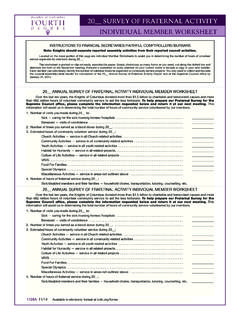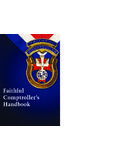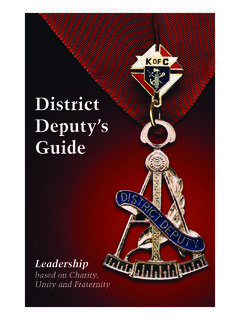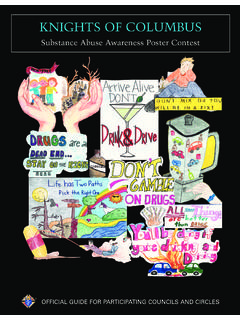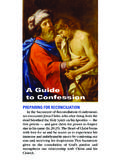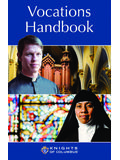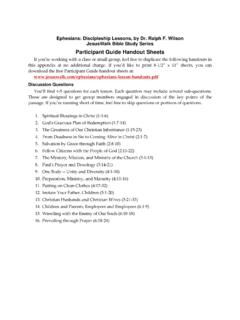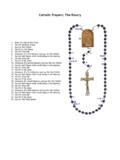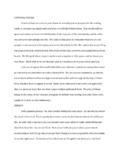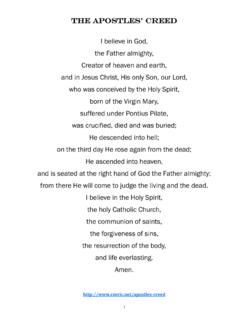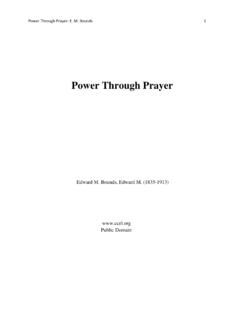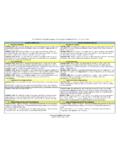Transcription of St. Joseph: Our Father in Faith
1 Building the Domestic Church Series St. Joseph: Our Father in Faith Father Frederick L. Miller Building the Domestic Church While Strengthening Our Parish The family as domestic church is central to the work of the new evangelization and to the future sustainability of our parishes.. Past Supreme Knight Carl Anderson The Knights of Columbus presents The Building the Domestic Church Series Saint Joseph: Our Father in Faith by Father Frederick L. Miller, General Editor Father Juan-Diego Brunetta, Catholic Information Service Knights of Columbus Supreme Council Nihil Obstat Censor Deputatus Reverend Monsignor James C. Turro, , Imprimatur Most Rev. John J. Myers, , Archbishop of Newark June 30, 2008. The Nihil Obstat and Imprimatur are official declarations that a book or pamphlet is free of doctrinal or moral error. No implication is contained therein that those who have granted the Nihil Obstat and Imprimatur agree with the contents, opinions or statements expressed. 2008-2021 by Knights of Columbus Supreme Council All rights reserved.
2 Cover: The Nativity (detail), Chapel of the Nativity, Sacred Heart University, Fairfield, Connecticut. Artist: Fr. Marko Rupnik, and the artists of Centro Aletti. Photo: Peter krlep/Tamino Petelinsek Knights of Columbus No part of this book may be reproduced or transmitted in any form or by any means, electronic or mechanical, including photocopying, recording, or by information storage and retrieval system, without permission in writing from the publisher. Write: Catholic Information Service Knights of Columbus Supreme Council PO Box 1971. New Haven CT 06521-1971. 203-752-4267. 800-735-4605 fax Printed in the United States of America CONTENTS. INTRODUCTION ..5. JOSEPH: THE MAN OF Faith ..8. JOSEPH: THE JUST MAN ..14. Did Joseph suspect Mary of adultery? ..16. Was Joseph confused? ..17. Joseph was awestruck by a mighty act of God! ..18. The Holy Spirit in the life of Saint SAINT JOSEPH AND THE SPIRITUAL LIFE ..22. God works in the world through people who believe in Him ..23.
3 Saint Joseph and the culture of life ..23. Terror of Model of Contemplation ..25. Saint Joseph and the Paschal mystery of Christ ..25. Prayer to Saint Joseph ..30. Memorare to Saint Joseph ..30. Litany to Saint Joseph ..31-32. NOTES ..33. FOR FURTHER READING ..35. ABOUT THE AUTHOR ..36. ST. JOSEPH: OUR Father IN Faith . INTRODUCTION. Even though the Evangelists do not record one word spoken by Joseph of Nazareth, the Holy Spirit has inspired Christians throughout the ages to love the husband of the Blessed Virgin Mary and foster Father of the Son of God. Because of Saint Joseph's relationship with Jesus and Mary, he enjoys a relationship with the Church that is foundational. Pope John Paul II has noted that Saint Joseph's example transcends all individual states of life and serves as a model for the entire Christian community, whatever the condition and duties of each of its members may be. 1. For every believer, Saint Joseph is a model of wholehearted love of Jesus Christ and his virgin Mother, an example of perfect fidelity to the will of God.
4 He is a teacher of holiness in marriage, chastity for the sake of the kingdom of God, the sanctity of human work and contemplative prayer. By his example, Saint Joseph teaches Christians how to love and serve Jesus Christ and live and die in his presence. He is a model for all the faithful: the laity, married and single, consecrated religious, and clergy. Throughout the centuries, the Church has experienced the love, manly strength and protection of Saint Joseph. The saints tell us that with the Mother of God, Joseph enjoys a singular power of intercession. Saint Teresa of Avila, for instance, in the Book of Her Life, wrote: I took for my advocate and lord the glorious Saint Joseph and earnestly recommended myself to him. I saw clearly that as in this particular need so in other greater ones concerning honor and loss of soul this Father and lord of mine came to my rescue in better ways than I knew how to ask for. I do not recall up to this day ever having petitioned him for anything that he failed to grant.
5 It is an amazing thing the great many favors God has granted me through the mediation of this blessed saint, the -5- dangers I was freed from both of body and soul. For with other saints it seems the Lord has given them grace to be of help in one need, whereas with this glorious saint I have experience that he helps in all our needs and the Lord wants us to understand that just as He was subject to Saint Joseph on earth for since bearing the title of Father , being the Lord's tutor, Joseph could give the Child command so in heaven God does whatever he For over a century, the successors of Saint Peter in the See of Rome have sought to spread and intensify the knowledge and love of Saint Joseph among Catholics. On Dec. 8, 1870, Blessed Pope Pius IX. named Saint Joseph the Patron of the Universal Church. In his encyclical on Saint Joseph, Quamquam Pluries, dated Aug. 15, 1889, Pope Leo XIII called the people of God to a renewed devotion to Saint Joseph. In this text, the pope described the Church on earth as Joseph's numberless family scattered throughout all lands, over which he rules with a sort of paternal authority, because he is the husband of Mary and the Father of Jesus Pope Saint Pius X approved the Litany of Saint Joseph for public use in the Church (see page XX).
6 Pope Benedict XV added the invocation to Saint Joseph to the Divine Praises that Catholics pray at the end of Benediction of the Blessed Sacrament. Pius XI named Saint Joseph the special protector of the Church against the assaults of communism. Pope Pius XII added the feast of Saint Joseph the Worker, May 1, to the Roman liturgical calendar in order to counteract further the influences of communism in Christian countries. In convoking the Second Vatican Council, Blessed Pope John XXIII entrusted it to Saint Joseph and named him its special patron. In 1962, at the conclusion of the first session of the council, the pope added a commemoration of Saint Joseph in the Roman Canon (Eucharistic Prayer 1). On Aug. 15, l989, to commemorate the 100 th anniversary of the publication of Pope Leo XIII's Quamquam Pluries, Pope John Paul II. published an apostolic letter on Saint Joseph entitled Guardian of the Redeemer (Redemptoris Custos). In a sense, it is a companion of the Holy Father 's encyclical on the Blessed Virgin, Mother of the Redeemer -6- (Redemptoris Mater).
7 These papal letters explain the Church's veneration of the Blessed Virgin and Saint Joseph as the persons closest to the incarnate Son of God. They also highlight the important place Mary and Joseph hold in the Church and in the spiritual life of every believer. Several men and women who have recently been either beatified or canonized have called the Church to a deeper appreciation of Saint Joseph's mission and power of intercession: Saint Elizabeth Ann Seton placed her Sisters of Charity, as well as the first parochial schools, under his patronage. Saint John Neumann, the fourth bishop of Philadelphia, joined two other 19th-century saints, Th r se of Lisieux and Bernadette Soubirous, in their frequent recourse to Saint Joseph in prayer. Blessed Jeanne Jugan, the foundress of the Little Sisters of the Poor, a congregation dedicated to caring for the aged poor, recognized Saint Joseph, the man who had taken the Blessed Virgin and her child into his home, as the model of the Christian hospitality that she and her sisters offer to their clients.
8 Blessed Andr Bessette, at the Shrine of Saint Joseph in Montreal, led scores of sick people to find physical healing and peace in the saint's intercession. Blessed Louis Guanella called attention to Saint Joseph as the patron of a happy death, that is, a death in the company of Jesus and Mary. Saint Jos maria Escriva, founder of Opus Dei, promoted Saint Joseph as the model of the sanctification of ordinary, daily work. Significantly, on Oct. 13, 1917, the occasion of the miracle of the sun at Fatima, in Portugal, Saint Joseph appeared with Mary and the child Jesus to Lucia, Jacinta, and Francisco, the seers of Fatima. The Holy Family was and is the icon of the Gospel of life that modern men and women, ensnared in the culture of death so desperately need to hear. Following the direction of Christ's vicars on earth, and the example of his saints, believers should seek a deeper understanding of Saint Joseph's role in the mystery of redemption, as well as cultivate an intimate, personal relationship with him in prayer.
9 The goal is to move closer to Saint Joseph in Faith and love. To attain this purpose, this reflection focuses on three themes: Joseph, the man of Faith ; Joseph, the just man, and Joseph, the spiritual Father of all Christians. -7- JOSEPH: THE MAN OF Faith . The Gospel of Matthew 1:18-25 describes Joseph's introduction to the mystery of the Incarnation. Following Pope John Paul II's teaching in Guardian of the Redeemer, one may entitle this text, Joseph's annunciation. In the apostolic letter, Pope John Paul II suggests that Luke 1:26-38 and Matthew 1:18-25 should be read together: There is a strict parallel between the annunciation' [to Joseph] in Matthew's text and the one in Luke [to Mary]. The divine messenger introduces Joseph to the mystery of Mary's motherhood. 4. Jesuit Father Joseph Fitzmeyer has identified 12 points that connect the texts of the Annunciation to Mary in Luke's Gospel and the annunciation to Joseph in Matthew's. Luke and Matthew agree on the following points: 1) Jesus' birth occurred in the days of Herod the Great.
10 2) Mary, a virgin, is engaged to Joseph. They have not yet come to live together. 3) Joseph is of the House of David. 4) An angel of heaven announces the birth of Jesus. 5) Jesus is recognized as a son of David. 6) Jesus' conception is said to take place through the Holy Spirit. 7) Joseph is not involved in the conception of Jesus. 8) The name Jesus is imposed on Him by heaven before His birth. 9) The angel identifies Jesus as Savior.. 10) Jesus is born after Joseph and Mary come to live together. 11) Jesus is born in Bethlehem. 12) Jesus settles, with Mary and Joseph, in Nazareth in Noting the points of contact between the two texts, Pope John Paul concentrates mainly on the content of the message revealed to both Mary and Joseph and their identical response of Faith . Whereas Luke presents the mystery through the eyes of Mary, and reveals her response, Matthew presents the identical mystery through the eyes of Joseph, and indicates his: -8- This is how Jesus Christ came to be born.

